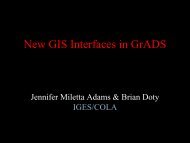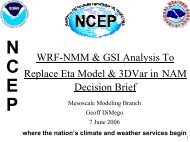The NCEP Climate Forecast System Reanalysis - NOAA National ...
The NCEP Climate Forecast System Reanalysis - NOAA National ...
The NCEP Climate Forecast System Reanalysis - NOAA National ...
You also want an ePaper? Increase the reach of your titles
YUMPU automatically turns print PDFs into web optimized ePapers that Google loves.
Figure 45: <strong>The</strong> fit of 6-hour forecasts of instantaneous surface pressure against irregularlydistributed observations also called the background error. Shown are annuallycompiled fits-to-obs data 1979-2008 in units of mbar. In blue SH ocean, inred NH land.Figure 46: Global mean temperature anomalies from 1000 to 1 hPa from January 1979through May 2009.Figure 47: Equatorial (5ºS to 5ºN) zonal mean U wind component time series from 1979to 2009.Figure 48: Zonal mean total ozone differences between the CFSR and the CohesiveSBUV(/2) Total Ozone Dataset. Units are in Dobson units. Also shown are<strong>The</strong> time spans of each satellite’s SBUV(/2) data used in the CohesiveSBUV(/2) Total Ozone Dataset.Figure 48: Zonal mean total ozone anomalies as a function of latitude vs time.Figure 49: Temporal lag correlation coefficient between precipitation and SST in thetropical Western Pacific (averaged over 10S-10N, 130E-150E) in R1 (red),R2 (brown), CFSR (green) and observation (black). GPCP daily precipitationand Reynolds ¼ o daily SST are used as observational data. Negative(positive) lag days on the x-axis indicate the SST leads (lags) theprecipitation. Data for the boreal winter (Nov-Apr) over the period 1979-2008are band-pass filtered for 20-100 days after removing the climatologicalmean.Figure 50: <strong>The</strong> subsurface temperature mean for an equatorial cross-section for CFSR (top)and observations from the World Ocean Atlas (Conkright et al., 1999).Figure 51: <strong>The</strong> subsurface zonal velocity for an equatorial cross-section for CFSR for theyears: 1979-2008.Figure 52: Vertical profiles of the subsurface temperature (top panels) and zonal velocity(bottom panels) for CFSR (red line) and TAO observations (black line) for fourlocations in the equatorial Pacific Ocean.Figure 53: <strong>The</strong> vertically averaged temperature (top 300 m) for CFSR for 1979-2008, andfor observations from the World Ocean Atlas (Conkright, et al., 1999).Figure 54: Zonal surface velocities for CFSR ( top left) and for drifters from the Surface- 87 -





